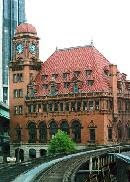Richmonders are no different than many people in the new urbanist world. They like the idea of moving back downtown where it is easy and efficient to travel to their offices without cars walk to restaurants and entertainment and have quick access to inner city depots for transportation out of town.
For Richmond, that ideal centers around the downtown Shockoe Slip and Bottom areas that feature the Main Street Station, an ornate 1901 train stop in a Renaissance Revival style. Urban planners and developers are scheming to have the station, which reopened for limited passenger service on Amtrak six years ago, become the focus of new world of condos, shops, offices and eateries along the area’s cobble stone streets.
Even more important, Main Street Station, being a downtown depot, figures in grand schemes to have higher speed rail trains rocket passengers north to Washington and to points south. President Barack Obama is a big fan of higher speed rail and has already distributed $8 billion to get it moving. One requirement is that the new trains must stop in downtown areas. Virginia got only $75 million in the first round of financing.
Therein lies the problem. The capital city’s movers and shakers had their balloon pricked when Thelma Drake, a former Virginia Beach congresswoman who is now Secretary of the Department of Rail and Public Transportation, told them that a new Amtrak train from Norfolk to Washington won’t be stopping at Main Street Station when it starts service in three years.
Lo and behold, the train will stop at Staples Mill Road station, an ugly building in Henrico County that handles most of Richmond’s rail traffic.
Some day Main Street Station may be used, but not now, she says. Why? CSX lines from Petersburg are the only ones with appropriate signals and other gear to handle northbound passenger trains. They go to Staples Mill Road station. For Main Street to accept such trains, it will cost about $600 million to refurbish a 15-mile-long line that runs from Centralia Road in Chesterfield County along an industrial maze along Interstate 95 and on to Main Street, as I note in an article in Style Weekly.
Richmond’s business elite, who dream of the days they can get to DC in 90 minutes from downtown, were horrified by this shocking tidbit of financial reality. One of Richmond’s many self-appointed “Leadership” groups that supposedly does the hard thinking and planning for area residents says it will cost only $122 million.
Whatever. Be it $600 million or $122 million, no one has that kind of transportation money in a state that is already $20 billion in the red for needed transport projects.
What’s more, some hard questions will need to be asked. Why spend hundreds of millions on northbound access to Main Street when Amtrak figures show that only 2,000 passengers a month use it on a few weekly trains that run from Newport News northward? Staples Mill Road sees 20,000 passengers a month. Even Charlottesville’s Amtrak stop has four times as many monthly passengers as current Main Street.
When I wrote about this little bit of fiscal reality in Style Weekly, commentators accused me of being everything from a twerp to a hack for suburban interests. What I am is merely a bearer of bad news.
Peter Galuszka



